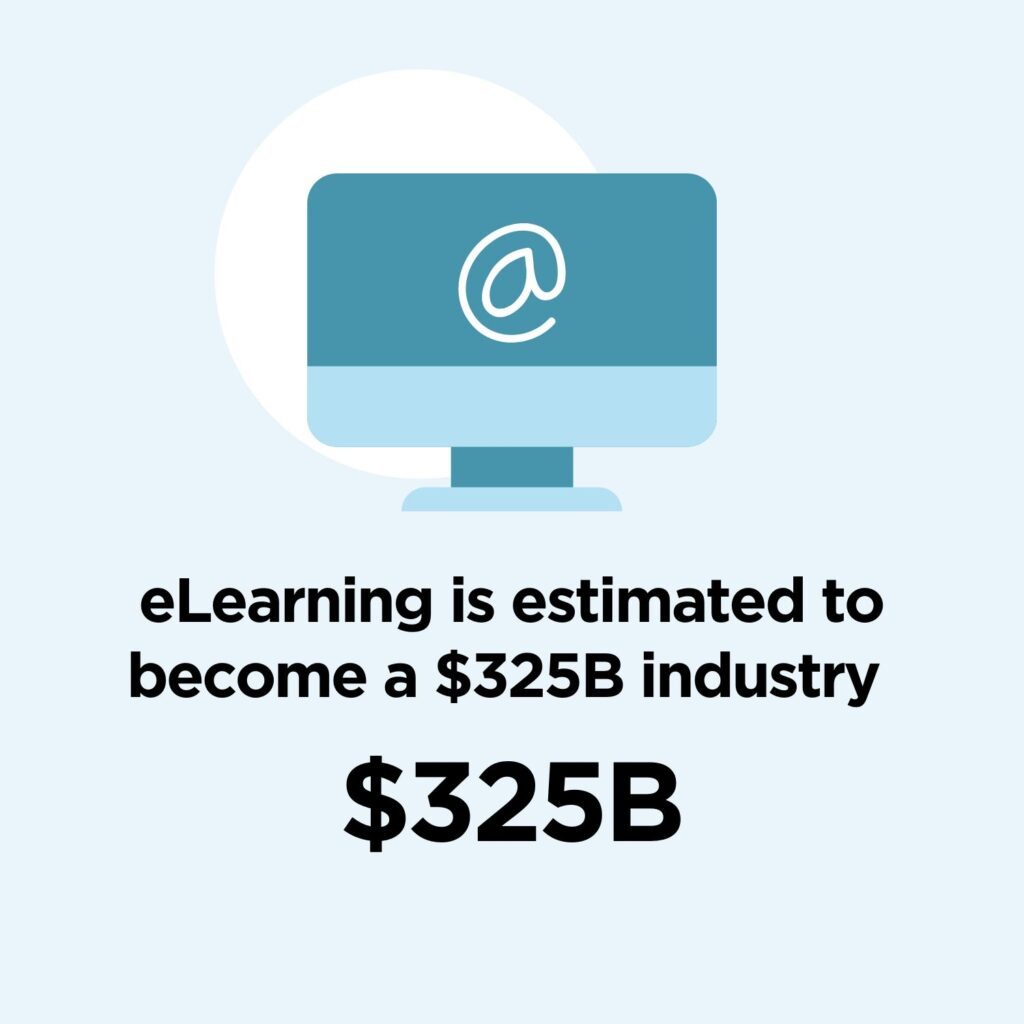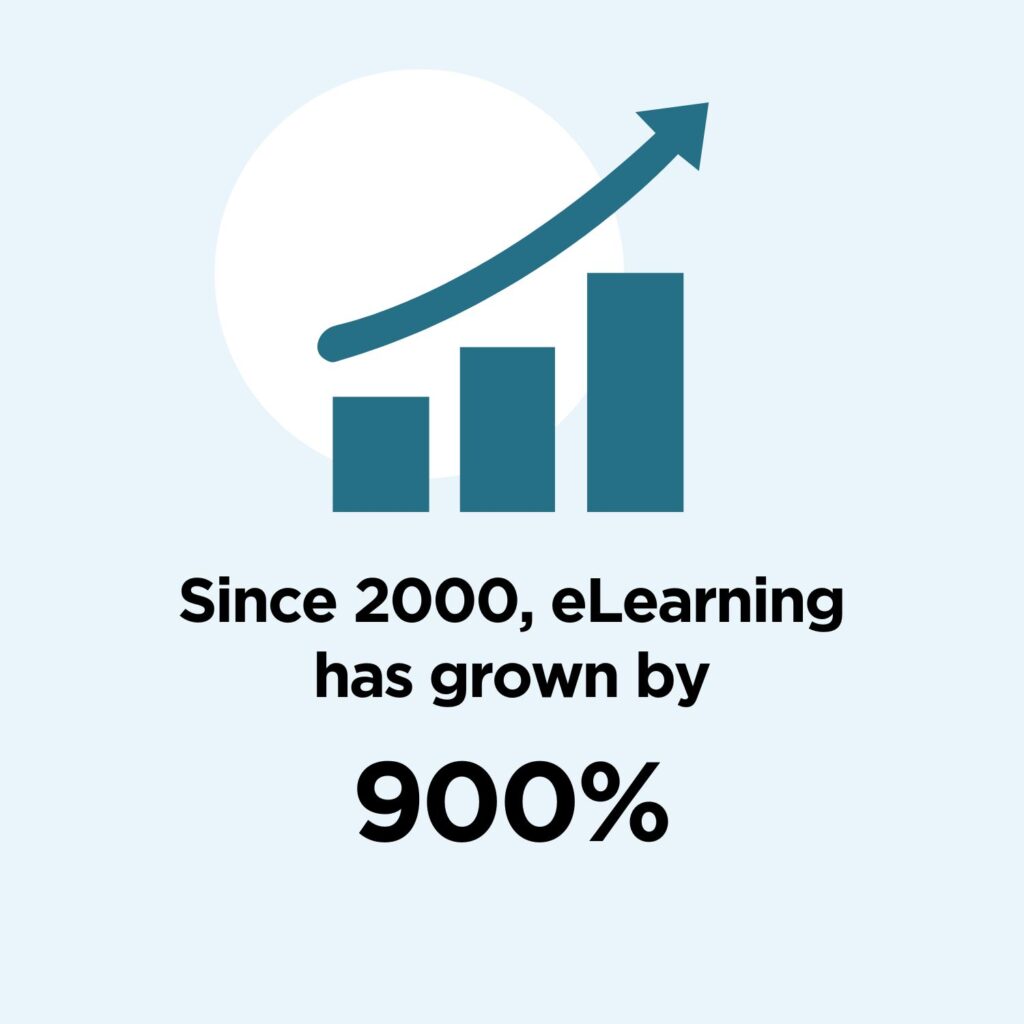What are the top eLearning statistics?
We did the research and compiled a definitive list of eLearning statistics. This stats list shares the top eLearning statistics and helps explain the state of the online education industry on a global scale for students and businesses.
Read on!
The top eLearning statistics in 2024
- The eLearning industry has grown by 900% since 2000
- Corporate eLearning is expected to grow by 250% by 2026
- 75% of schools in the US plan to operate completely online
- Students retain 25%-60% more through online courses
- Corporate eLearning is 40%-60% less time-consuming that traditional learning
- 98% of US corporations planned on using eLearning
- 40% of Fortune 500 companies use eLearning
- eLearning is estimated to be worth $325 billion by 2025
- eLearning reduces energy consumption by 90%
What is eLearning?
The term “eLearning” was coined in 1999, short for “electronic” learning. eLearning, also referred to as online learning, refers to learning from a distance (or remotely) because the materials and/or trainings are delivered digitally. eLearning is a wide net that consists of online courses, employer training courses to online college courses to K-12 students.
This technological form of learning involves digital resources and web-based applications, like course management systems. These allow learners to interact with faculty and classmates via email or chat sessions while attending online classes, downloading resources, and other course-related activities.
To participate in eLearning, students usually only require a device such as a computer, tablet, or smartphone and wifi accessibility. This low barrier to entry makes eLearning more accessible, along with providing other key benefits.
But what are the benefits of eLearning?
Simply put, eLearning makes it easy for users to learn anytime, anywhere, with few, if any, restrictions.
Here are some of the benefits of eLearning:
- Cost-Effective – eLearning doesn’t require costly print materials or a classroom, greatly reducing the overhead of education cost.
- Saves Time – eLearners don’t need to commute to and from a traditional classroom, plus they gain the opportunity to study and learn at their own pace.
- Adaptable – Employers and teachers can easily update courses on the fly.
- Improves Performance – eLearners train quickly and easily, absorbing new skills.
- Productivity – eLearning keeps learners engaged giving them an 18% boost in productivity (more on that later).
- Higher Revenues – Studies show that companies who invest in online employee training yield higher revenues that their competitors.
- Environmentally Friendly – eLearning provides a paperless alternative and eliminates unnecessary commuting, significantly reducing education’s overall CO2 impact.
General eLearning statistics in 2024
1. The online eLearning market is estimated to be worth $325 billion by 2025
(Forbes)
In just three more years, experts have projected the eLearning market to be worth $325 billion globally. Ten years earlier in 2015, global industry analysts projected eLearning to reach $107 billion—and it did. In short, the eLearning market has nearly doubled in the past decade.

2. 75% of schools in the U.S. plan to operate completely online
(MarketScale)
Industry insights revealed that three-quarters of schools in the United States plan to operate either completely remote or via a hybrid learning model this school year. 74 of the 100 largest school districts in America chose remote learning as their back-to-school instructional method. Almost half of these (49%) opened the school year with remote learning opportunities while 27% offered hybrid instruction.
3. eLearning reduces energy consumption by 90%
(Growth Engineering)
A study by the Open Design Innovation Group discovered that nearly 90% less energy is used for online training programs than in-class training programs. This means huge energy savings, considering a single university can consume over 120 million kWh per year. One university in particular had great success saving 4,000 hours of lighting by reducing classroom use. This saved the school thousands of dollars and prevented the creation of 19 tons of CO2 emissions.
4. Over 80% of all online activity is due to video web activity with the majority being educational or training clips
(Finances Online)
So what do people do to eLearn? It turns out that over 80% of the time spent online is watching videos. The majority of this video time is used consuming learning videos or training clips. This is positive, considering videos are 9% easier to recall than text-only content. Employees prefer video, as 70% said they’d rather watch a video than read a written document.
Growth of online education statistics
5. The eLearning industry has grown by 900% since 2000
(Skill Scouter)
In the last twenty years, the eLearning industry has grown by 900%. Continuing the trend, it is expected to triple in size from 2020 to 2025. A growing industry means more profit too since between 2017 and 2022, the eLearning market was expected to increase by more than $6 billion.

6. The U.S. eLearning market is estimated to grow by $12.81 billion between 2020-2024
(Business Wire)
The eLearning market is growing rapidly. From 2020 to 2024, is projected to grow by almost $13 billion. This forecast period has a CAGR of over 12%. The leading players driving growth are Adobe, Cengage Learning, Citrix, Houghton Mifflin Harcourt Co., McGraw-Hill Education, Pearson and others.
7. Since 2020, 98% of universities moved classes online
(Admissionsly)
Almost all universities have evolved to offer online classes. By the end of 2021, 40% of public univeresities and 20% of private institutions migrated their online classes to full-time. About 9% of post-baccalaureate students were enrolled completely in online school while 1% took at least one online course.
8. 80% of schools have purchased or are purchasing additional technology for students
(Market Scale)
Schools know that eLearning is the new norm and are taking action to adapt. 80% of schools have either purchased or plan to purchase additional devices to further enable eLearning. Since January 2020, the number of new devices first connecting to the internet increased by 205%, largely because of schools building their inventory of student devices to support online learning.
9. The Massive Open Online Course (MOOC) market is projected to grow to $25.33 billion by 2025
(Global Newswire)
Massive Open Online Courses, or MOOCs , are free online learning platforms for students worldwide. MOOCs allow unlimited access to valuable courses, educational resources, expert guidance, and discussion forums across a wide range of class categories. “Free” education through MOOCs is currently worth over $5.16 billion and projected to grow at an annual rate of 32.09%. This will take the MOOC market to $25.33 billion by 2025.
10. By the end of 2021, the mobile eLearning market was projected to become a $38 billion market
(Finances Online)
Mobile learning is opening up eLearning to even more people. This mobile market was estimated to surpass $38 billion by the end of 2021. Mobile learning is projected to reach a market size of over $80.1 billion by 2027 and a CAGR of 20%. This high growth rate is largely due to the COVID-19 pandemic accelerating online learning and embracing remote opportunities.
Do students prefer online learning?
11. 81% of U.S. college students say that eLearning technology is helping them improve their grades
(Statista)
Eight out of 10 American college students believe that DLT, or digital learning technologies, is helping them improve their grades. How? eLearning allows 66% of students who are behind in school to catch up. Another 73% of students believe that eLearning lets students study and work at their own pace.
12. 79% of teachers found technology makes learning more interesting
(Statista)
Almost 80% of teachers in a 2016 survey said that they think technology makes a big, and positive, difference for students: Technology makes learning more fun. Other positive perceptions of online learning include 74% of educators who believe it presents learning opportunities outside of the classroom and 72% who think it customizes the learning experience.
13. 9 in 10 students think online learning is the same or better than the traditional classroom experience
(Small Business Trends)
eLearning isn’t just widely accepted, but it’s preferred. 90% of students believe that eLearning provides the same, if not better, experience than a traditional classroom. Corporations have increased their use of eLearning by 900% in the last 16 years and this number is only projected to continue rising.
How efficient is eLearning?
14. Students retain about 25%-60% more via online courses
(Shift Learning)
According to a study from The Research Institute of America, eLearning increases the retention rate of students. Learning online yields retention rates of 25 to 60% while face-to-face training is lower, only yielding 8 to 10%. Why? Experts say this increase in retention is because eLearning gives students more control of the process, allowing them to revisit lessons and learn at their own pace.
15. eLearning participants learned 5x more material without increasing the time spent training
(Shift Learning)
IBM implemented eLearning training programs for their employees and proved how efficient it can be. Online, learners were able to learn almost 5 times more material without spending more time training. Many employees prefer training online since eLearning typically requires 40 to 60% less employee time than learning the same material in a traditional classroom environment.
Corporate eLearning statistics
16. It’s estimated that corporate eLearning will grow by over 250% by 2026
(Business Wire)
In 2017, the global corporate eLearning market accounted for $14.23 billion. By 2026, experts predict this corporate segment to explode to $49.87 billion. Corporate eLearning is growing at a CAGR of 15% steadily. So, from now until the end of this forecasted period, we can expect more and more corporations adopting online learning.
17. Around 40% of Fortune 500 companies use eLearning for training
(Skill Scouter)
Fortune 500 companies make up some of the most successful businesses in the world, and 40% of them use eLearning regularly and extensively. At these large firms, 73.6% of technology-delivered training is shared online or through a network of sorts.
18. In 2020, 98% of corporations planned on using eLearning
(Small Business Trends)
In 2017, about 77% of U.S. corporations said that they used online learning. Meanwhile, almost all of the companies (98%) planned on implementing eLearning methods by 2020. The same study also showed that 98% of corporations said they would implement video as part of their digital learning strategy.
19. 90% of companies offer employees some form of digital learning
(LinkedIn)
According to a study from LinkedIn, 9 in 10 companies today offer digital learning opportunities. So, how do employees prefer to learn? 68% want to learn while at work, 58% prefer to learn at their own pace, and 49% want to learn when they need it.
20. 67% of companies offer eLearning through smartphones
(eLearning Industry)
eLearning doesn’t just happen behind big desktop computers. It turns out that 67% of companies offer some kind of mobile learning. Better yet, 99% of these mobile users believe that mobile learning enhances their educational experiences. The mobile eLearning market was expected to reach $37.6 billion by 2020.
21. Companies with training programs have 218% higher revenue per employee
(eLearning Industry)
Companies with extensive training programs are earning 218% higher revenues, a number directly correlated to the number of employees they train. According to Deloitte, the average employee needs to dedicate approximately 1% of their time per week to training. This small time investment empowers employees to stay up to date with best practices, upskill their abilities, and learn about developments in the industry.
22. IBM saved around $200 million after switching to eLearning
(Shift Learning)
IBM is a big fan of eLearning. Why? This Fortune 500 company saved approximately $200 million after it switched its employee training to eLearning methods. The same IBM study revealed that investing in employees pays off, a lot. For every dollar invested in online training, it resulted in $30 in productivity. That’s because employees can resume work faster and apply their newly learned skills immediately.

23. Dow Chemicals saved $34 million by switching to eLearning tools
(Research.com)
Dow Chemicals is similar to IBM in that this giant company also saved a significant chunk of money thanks to eLearning. Dow Chemicals saved a reported $34 million because it was able to reduce training course costs. It traditionally cost the company $95 per learner and by switching to eLearning, that cost dropped to just $11 per learner.
24. Companies that use eLearning see an 18% boost in employee engagement
(Molly Fletcher)
Employees that participate in eLearning experience a 18% boost in engagement. This boost in motivation comes from happier and more confident employees. Studies show that companies with an actively engaged workforce produce 2.6 times the earnings per share when compared to its competitors.
25. 94% of employees would stay at a company longer if it invested in their career development
(LinkedIn)
According to a 2018 study by LinkedIn, the top challenge for talent development was “getting employees to make time for learning.” Yet, 94% of employees would happily stay longer at a company if it invested in their professional development. 56% of employees want help from their managers on this. This group said they would spend more time learning if their manager directed them to complete a specific course.
Statistics on disadvantages of online learning
26. An increase in eLearning has led to a 30% increase in failing grades
(Research Gate)
eLearning could be the cause of an uptick in failing students. The growth of the eLearning industry has led to a 30% increase in failing grades. A survey of 1,000 students revealed that 78% of them think it is easier to learn inside of a classroom. While eLearning has many benefits, there are many students (college and younger) that prefer learning in the traditional classroom.
27. K-12 devices used for eLearning only meet compliance rates 60% of the time
(MarketScale)
Schools across America have experienced an unprecedented amount of ransomware attacks since 2019. Some massive attacks caused weeks of school-wide shutdowns in the start of the 2020-2021 academic school year. These attacks happen because on average, devices used for K-12 eLearning only meet compliance rates 60% of the time. The average patch age for a Microsoft Windows 10 is 183 days while Apple MacOS devices average at 31 days, leaving plenty of time for hacks and vulnerabilities.
28. An average of one hour per day is spent on sites with inappropriate content
(MarketScale)
Student aren’t always “learning” when they are behind a computer. Studies show that on average, one hour of daily device usage was spent on sites with inappropriate content. The web filtering solutions that school networks try to enforce have failed to work properly when eLearning devices are disconnected. 41% of schools saw rogue VPNs within their device environments.
29. Over 40% of school IT teams are challenged with tracking lost or missing devices
(MarketScale)
Since January 2020, reports show that there has been a 205% increase in the number of brand new devices connecting to the internet for the first time. That’s the result of many schools buffing up their eLearning device inventory, which needs to be monitored. More than 40% of school IT teams said that tracking these devices presents a “significant challenge.”
eLearning statistics in the U.S.
30. 63% of US high school students use digital tools every day
(Statista)
A 2019 survey revealed that 63% of American high schoolers use digital learning tools at school every day compared to 45% of elementary school students. This study was conducted pre-pandemic, so experts believe this eLearning statistic to be even higher today.
31. The U.S. accounted for more than 35% of eLearning revenues in 2020
(Finances Online)
North America, primarily the United States, was responsible for over 35% of global eLearning revenue in 2020. The Asia-Pacific market is projected to be the fastest growing eLearning market and is expected to account for 26% of the global eLearning market by 2027.
32. The U.S. government spends billions on eLearning for its staff
(Credential Engine)
Researchers estimated that U.S. government agencies spent $11 billion on training expenditures. It is approximated that $1.2 billion was spent on training civilian government employees and roughly $9.8 billion used to train state and local government workers.
eLearning statistics in the UK
33. 1.35 million digital devices were delivered to schools in England
(Statista)
In July 2021, over 1 million digital devices were ordered by schools in the United Kingdom to keep up with the demand for eLearning. This isn’t surprising considering 86% of classes were taught remotely in February 2021. But eLearning in the U.K. stretches beyond traditional academia. 13% of British people said they tried an online course in 2020.
34. 27% of students in the U.K. were unable to access online learning during the 2020 lockdown
(Finances Online)
One in four students within the United Kingdom couldn’t access online learning during their COVID-19 lockdowns in 2020. That means 27% of students suffered in education. Statista found that the main barrier to eLearning within the U.K. is access to digital devices.
Frequently asked questions
What percentage of companies use eLearning?
90% of companies offer some type of eLearning to their employees. What’s more, corporate eLearning is expected to grow by over 250% by 2026.
How effective is online learning?
Students retain about 25%-60% more via online courses because they have more control over the learning process. They also learn 5x more without increasing the time spent on learning.
Over to you!
And just like that, you learned 34 eLearning statistics. The facts and figures prove that the future of eLearning is bright.
Want to learn more about selling online courses?
Further reading:
The Ultimate Guide: Online Course Design
Sources:




